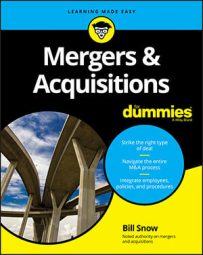Because contacting every company in this world and beyond for your M&A deal doesn’t make much sense, you need to make sure you have the right type and number of targets on your list.
You do this by initially making the target list larger than it needs to be. To create the initial target list, take all the targets on your and your advisors’ shortlists and then expand that list by applying your search criteria. Really dig in by dive-bombing online research sites.
If a company is obviously not a fit, discard it, but if you’re not sure whether a company should be included in the initial target list, leave it in. The idea of this step is to err on the side of too wide a fit. If the company isn’t a right fit, you weed it out in the next phase.
The initial target list will be larger than the final target list. Having 200 to 300 targets on the initial list isn’t unheard of, nor is that a bad thing. Having an initial target list of that size increases the odds that you’ll have a strong final list after you winnow it down.
After you’ve created your initial target list, you want to review that list with your team and reduce it to a reasonably sized final list.
To prepare for this review, have someone who works for you print up as much information about the targets as possible, including pertinent reports found from online research sites. These reports contain contact info, URLs, financial info, employee counts, and brief descriptions of the companies.
Next, you want to have the person go through and print the websites of the target companies. If you want to save a forest, use a projector and a computer to review the websites. However, and with apologies to environmentalists, printing copies of reports so everyone can have quick access to the financials is still probably the best bet.
Usually, a junior executive or some other low-level creature does the target list research because it’s rather tedious and time-consuming work. Don’t let this delegation make light of the importance of the research, though.
Without a good target list of Buyers or Sellers, your M&A dreams stand a very good chance of being dashed. Take this duty very seriously; if you aren’t doing it yourself, entrust the right person. Alternately, you can also hire an investment banking firm to take care of it.
During the review, the idea is to assess each company and talk about what it does, its financial situation, its history of doing deals, and whether it’s a suitable target. This process is a pain. It’s a bit like going to the dentist: It’s no fun, but it’s ultimately a good thing.
Doing this review as a group is important. You need the feedback and the ability to rapidly bounce ideas off each other. You should get the group together in one room rather than use conference calls for this part of the process.
Reviewing the initial target list will likely take half a day. At the end of this process, you should have a manageable final target list that’s shed of all the tweeners, borderline cases, or whatever term you want to use for “almost, but not quite.”
Hold on to all those “rejected” targets. If your A-list targets don’t yield what you’re looking for, you can review the previously rejected targets and consider adding them into the mix.

